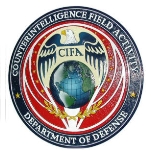A highly secret office located within the Department of Defense (DoD), the Counterintelligence Field Activity (CIFA) was charged with protecting US military personnel and facilities against spying and acts of terrorism. Information regarding CIFA’s budget and number of personnel is classified. CIFA’s primary mission was to identify and track down suspected terrorists. In 2005 news reports revealed that CIFA had been spying on peace activists and Iraq war protesters and was implicated in the bribery scandal of former Congressman Randy “Duke” Cunningham. CIFA was shut down in August 2008 and its activities were folded into the Defense Intelligece Agency (DIA).
Is Military Creeping Into Domestic Law Enforcement? (by Robert Block and Gary Fields, Wall Street Journal)
Pentagon and Contractors One Happy Family? (by Tim Shorrock, Inter Press Service)
Many in Government Helped Cunningham Or Yielded, Panel Finds: Report Indicates Widening Investigation (by Walter Pincus, Washington Post)
- Table of Contents
- Overview
- History
- What it Does
- Where Does the Money Go
- Controversies
- Suggested Reforms
- Comments
- Leave a comment


Scott Jacobs joined the Naval Criminal Investigative Service (NCIS) in 1981 and served in Seattle; Yokosura, Japan; and New Jersey. In 1992 he was chosen to be the Assistant Special Agent in Charge of the Metropolitan Northeast Field Office in New Jersey. After receiving a Brooking Institute fellowship, he served on the staff of Rep. Jim Saxton (R-NJ), focusing on environmental issues. Jacobs then became the Executive Assistant to the Deputy Director of the Naval Criminal Investigative Service. In 1996 he was promoted to Deputy Assistant Director for Economic Crimes, overseeing economic crime investigations in the Navy. From 2001 until 2004 Jacobs was in charge of the NCIS’ Northwest Field Office. In 2005 he was promoted to Executive Assistant Director for Combating Terrorism. Jacobs was appointed acting director of the Counterintelligence Field Activity in March 2008. CIFA was shut down in August 2008.
- Latest News
- D.C. Public Schools will Teach all Second-Graders to Ride a Bike
- New Rule in Germany Limits Sales of Sex-Themed E-Books to 10pm to 6am
- What Happened to the 6-Year-Old Tibetan Boy the Chinese Government Kidnapped 20 Years Ago?
- U.S. Ambassador to Turkey Photoshops his Hair Color to Mock Turkish Mayor
- Mystery Artist Calls Attention to Unfixed Potholes by Drawing Penises around Them
A highly secret office located within the Department of Defense (DoD), the Counterintelligence Field Activity (CIFA) was charged with protecting US military personnel and facilities against spying and acts of terrorism. Information regarding CIFA’s budget and number of personnel is classified. CIFA’s primary mission was to identify and track down suspected terrorists. In 2005 news reports revealed that CIFA had been spying on peace activists and Iraq war protesters and was implicated in the bribery scandal of former Congressman Randy “Duke” Cunningham. CIFA was shut down in August 2008 and its activities were folded into the Defense Intelligece Agency (DIA).
Is Military Creeping Into Domestic Law Enforcement? (by Robert Block and Gary Fields, Wall Street Journal)
Pentagon and Contractors One Happy Family? (by Tim Shorrock, Inter Press Service)
Many in Government Helped Cunningham Or Yielded, Panel Finds: Report Indicates Widening Investigation (by Walter Pincus, Washington Post)
Comments


Scott Jacobs joined the Naval Criminal Investigative Service (NCIS) in 1981 and served in Seattle; Yokosura, Japan; and New Jersey. In 1992 he was chosen to be the Assistant Special Agent in Charge of the Metropolitan Northeast Field Office in New Jersey. After receiving a Brooking Institute fellowship, he served on the staff of Rep. Jim Saxton (R-NJ), focusing on environmental issues. Jacobs then became the Executive Assistant to the Deputy Director of the Naval Criminal Investigative Service. In 1996 he was promoted to Deputy Assistant Director for Economic Crimes, overseeing economic crime investigations in the Navy. From 2001 until 2004 Jacobs was in charge of the NCIS’ Northwest Field Office. In 2005 he was promoted to Executive Assistant Director for Combating Terrorism. Jacobs was appointed acting director of the Counterintelligence Field Activity in March 2008. CIFA was shut down in August 2008.
- Latest News
- D.C. Public Schools will Teach all Second-Graders to Ride a Bike
- New Rule in Germany Limits Sales of Sex-Themed E-Books to 10pm to 6am
- What Happened to the 6-Year-Old Tibetan Boy the Chinese Government Kidnapped 20 Years Ago?
- U.S. Ambassador to Turkey Photoshops his Hair Color to Mock Turkish Mayor
- Mystery Artist Calls Attention to Unfixed Potholes by Drawing Penises around Them





Comments